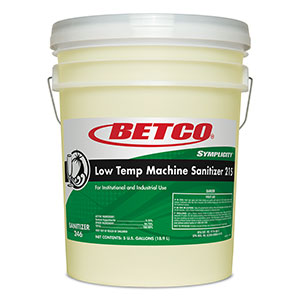
Log In To View Price
SANITIZER SP2460500 SYMPLICITY LOW TEMP MACHINE 5 GAL PAIL
- Availability:In Stock
- Stock #:38397
- Description:
EPA registered sodium hypochlorite based sanitizer for use in low temperature and low energy dishmachines. It sanitizes ware and aids in stain and protein soil removal on plastic, china, and tableware in the wash cycle. Low Temp Machine Sanitizer 215 is safe for use on stainless steel, glass, china, porcelain and plastic. Not recommended for use on sterling silver plate or other soft metals.
Read the entire label before using this product. It is a violation of Federal Law to use this product in a manner inconsistent with its labeling. NOTE: This product degrades with age. Use a chlorine test kit and increase dosage, as necessary, to obtain the required level of available chlorine.
SANITATION OF NONPOROUS FOOD CONTACT SURFACES RINSE METHOD: A solution of 100 ppm available chlorine may be used in the sani- tizing solution if a chlorine test kit is available. Solutions containing an initial con- centration of 100 ppm available chlorine must be tested and adjusted periodically to ensure that the available chlorine does not drop below 50 ppm. Prepare a 100 ppm sanitizing solution by thoroughly mixing 3 fl. oz. of this product per 10 gallons of water. If no test kit is available, prepare a sanitizing solution by thoroughly mixing 5.5 oz. of this product per 10 gallons of water to provide approximately 200 ppm available chlorine by weight. Clean equipment surfaces in the normal manner. Prior to use, rinse all surfaces thoroughly with the sanitizing solution, maintaining contact with the sanitizer for at least 2 minutes. If solution contains less than 50 ppm available chlorine, as determined by a suitable test kit, either discard the solution or add sufficient product to re-establish a 200 ppm residual. Do not rinse equipment with water after treatment and do not soak equipment overnight. Sanitizers used in automated systems may be used for general cleaning but may not be re-used for sanitizing purposes. IMMERSION METHOD: A solution of 100 ppm available chlorine may be used in the sanitizing solution if a chlorine test kit is available. Solutions containing an initial concentration of 100 ppm available chlorine must be tested and adjusted periodically to ensure that the available chlorine does not drop below 50 ppm. Prepare a 100 ppm sanitizing solution by thoroughly mixing 3 fl. oz. of this product per 10 gallons of water. If no test kit is available, prepare a sanitizing solution by thoroughly mixing 5.5 oz. of this product per 10 gallons of water to provide approximately 200 ppm available chlorine by weigh. Sanitizers used in automated systems may be used for general cleaning but may not be re-used for sanitizing purposes. LOW/PRESSURE METHOD: Disassemble equipment and thoroughly clean after use. Assemble equipment in operating position prior to use. Prepare a volume of 200 ppm available chlorine sanitizing solution equal to 110% of volume capacity of the equipment by mixing this product in a ratio of 5.5 oz. per 10 gallons of water. Pump solution through the system until full flow is obtained at all extremities, the system is completely Filled with the sanitizer and all air is removed from the system. Close drain valves and hold under pressure for at least 2 minutes to ensure contact with all internal surfaces. Remove some cleaning solution from drain valve and test with a chlorine test kit. Repeat entire cleaning/sanitation process if solution contains less than 50 ppm available chlorine. CLEAN-IN-PLACE METHOD: Thoroughly clean equipment after use. Prepare a volume of a 200 ppm available chlorine sanitizing solution equal to 110% of volume capacity of the equipment by mixing this product in a ratio of 5.5 oz. per 10 gallons of water. Pump solution through system until full flow is obtained at all extremities, the system is completely filled with the sanitizer and all air is removed from the system. Close drain valves and hold under pressure for at least 10 minutes to ensure contact with all internal surfaces. Remove some cleaning solution from drain valve and test with a chlorine test kit. Repeat entire cleaning/sanitation process if solution contains less than 50 ppm available chlorine.
Also Purchased
Products to consider when purchasing this item
